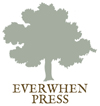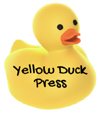 •
H O M E • W
R I T E R 'S N I B S • L
I N K S • B
L O G •
C O N T A C T •
•
H O M E • W
R I T E R 'S N I B S • L
I N K S • B
L O G •
C O N T A C T •
• S
C R I B B L I N G S •
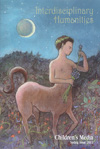
INTERDISCIPLINARY
HUMANITIES
Classroom Comics
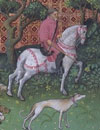
PRIMITIVE ARCHER MAGAZINE
Hunting Through
Medieval Literature

HORSE
& RIDER MAGAZINE
A Whisper and a Prayer
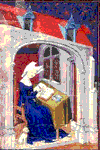
COURSE CURRICULUM
ARTICLE
Christine de Pizan
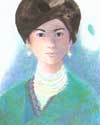
GODDESSES
IN WORLD CULTURE
The Maiden with a
Thousand Slippers
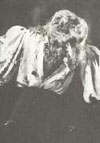
CONFERENCE
PAPER
Hostages
in the Rose Garden
"If
you steal from one author, it's plagiarism; if you steal from many, it's
research."
Wilson Mizner, 1876-1933, American Author
(Please use appropriate citations)
This essay appeared in the Interdisciplinary Humanities Journal, Spring, 2006 through EBSCO databases, including Academic Search Premier.
THE
BROKEN MIRROR:
A Freudian Slip into a Hellenistic Victorian Gynoculture
by Doré Ripley, ©2004-23
ARTHUR RACKHAM'S illustrations for Peter Pan in Kensington Gardens present a microcosmic reflection of an idealized Victorian society. The Hellenistic portrayal of Peter reflects the desire of the English Empire’s imperialist boy’s club to manifest itself as a mirror of Greek male culture and escape the dehumanizing industrial revolution. Peter Pan’s connection to the Hellenist movement, popular among leading academicians and intellectuals of the age, marginalizes him in two worlds: the domain of human children and the realm of the fairies. Further, this ambiguity communicates Victorian society’s ambivalent view of youngsters, Rackham’s intended audience. The psychological interpretation of products of the unconscious, in this case Rackham’s illustrations for Peter Pan, sheds light on a society longing for a Hellenistic homosocial culture by reflecting gynosocial images of the women happily haunting the confines of the home.
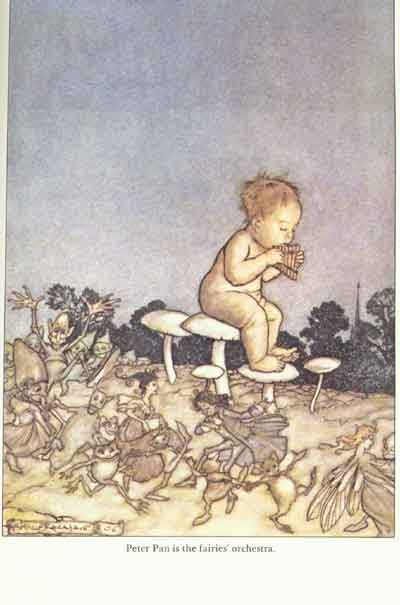
Figure 1. Rackham, Arthur. “Peter Pan is the fairies’ orchestra.” Peter Pan in Kensington Gardens by J.M. Barrie, “a facsimile of the 1906 edition.” New York: Weathervane Books, 1975.
– • –
Published in 1906, Peter Pan in Kensington Gardens marks the third appearance [1] of J.M. Barrie’s boy, or in this case, baby who refused to grow up. Instead of the preadolescent youngster familiar to modern readers (and movie goers), the Peter Pan inhabiting Kensington Gardens is a seven-day-old baby who refuses to remain human, consequently becoming a half-human, half-bird theriomorph trapped in an infant’s body. By returning to “the island on which all the birds are born that become baby boys and girls” (Barrie 15), Peter rejects his marginalized status in human society while returning to a community he no longer resembles. His otherness isolates him from his former bird community and terrifies the fairy society—“[e]very living thing was shunning him” (Barrie 26). Eventually Peter realizes his theriomorphic state, thereby destroying his ability to fly, forever trapping him “Betwixt-and-Between” (Barrie 29). Dissatisfied and rejected, Peter finds his way into the gardens where he becomes acquainted with the stratified fairy community, the garden’s nocturnal occupants. Barrie describes the “aristocratic fairy” (92) community of “blue bloods” (93) where the “high-born” (93) snub “simple little creature[s]” (94) like the social-climbing Brownie, “a poor street singer” (94). Upon Peter’s appearance, the male fairies take up arms to kill Peter, but the women “straightaway loved him, and grieved that their laps were too small” (Barrie 49) to hold and caress the half-human infant Peter. In June 1905, J.M. Barrie presented this version of Peter Pan to Arthur Rackham for illustration of a gift book for the 1906 Christmas season (Hudson 62).
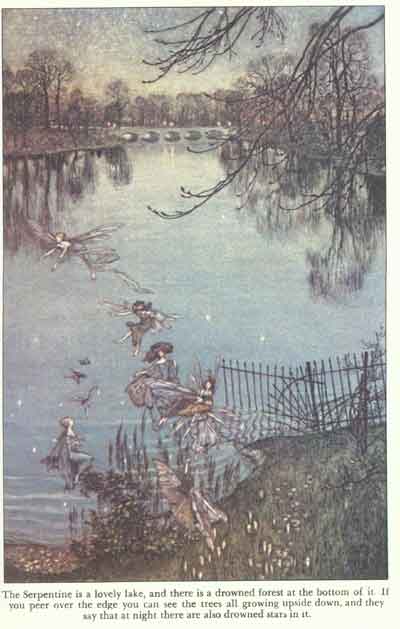
Figure 2. Rackham, Arthur. “The Serpentine is a lovely lake, and there is a drowned forest at the bottom of it. If you peer over the edge you can see the trees all growing upside down, and they say that at night there are also drowned stars in it.” Peter Pan in Kensington Gardens by E.M. Barrie, “a facsimile of the 1906 edition.” New York: Weathervane Books, 1975.
– • –
How does one illustrate the world of a flying baby who refuses to grow up? Arthur Rackham earned fame and fortune for his illustrations of fairies, trolls and other fanciful creatures. Born in 1867, one of twelve children, he displayed an early aptitude for drawing, (Hudson 24). After graduating from art school, he became a clerk, having to wait until the 1890s before gaining artistic employment (Plant 1). His early work, described as competent but rather uninspired, developed during the mid-1890s when he began creating his trademark whimsical drawings (Plant 2). Rackham became especially popular with children, who, when “contemplat[ing] Mr. Rackham’s drawings,…understood them at once and entirely” (Hudson 50). Classically erotic in nature, many of Rackham’s Peter Pan paintings illustrate a matriarchal gynoculture reminiscent of an idealized Victorian middle-class household. Rackham spent a year creating the fifty illustrations for Peter Pan in Kensington Gardens, and when Barrie viewed the drawings, he wrote him saying, “I am always your debtor…and please, I hope you will shed glory on more of my things” (Hudson 66). Barrie and Rackham’s creative collaboration on Peter Pan in Kensington Gardens produced “one of the most popular gift books of the Edwardian era” (Bayntun 1).

– • –
In Creative Writers and Daydreaming Freud asserts, “The creative writer does the same as the child at play. He creates a world of phantasy which he takes very seriously” (144), where “[t]he motive forces of phantasies are unsatisfied wishes, and every single phantasy is the fulfillment of a wish” (146). The “past, present, and future are strung together, as it were, on the thread of the wish that runs through them” (148), so that, “we can immediately recognize His Majesty the Ego, the hero alike of every day-dream and of every story” (150). “A piece of creative writing, like a day-dream, is a continuation of, and a substitute for, what was once the play of childhood” (152). On a socio-cultural level, Freud believes “[s]ublimation of instinct is an especially conspicuous feature of cultural development; it is what makes it possible for higher psychical activities, scientific, artistic or ideological, to play such an important part in civilized life” (Civilization 44). “Civilization is after all built entirely on renunciation of instinct” (Short 207) where, “predominately, though not exclusively, sexual instinctual impulses…have succumbed to this cultural suppression” (Short 207). The text of Peter Pan represents the repressed Barrie deserting his mother, thereby mimicking his brother’s death, and subsequently returning in the form of the dead son/brother only to find himself barred from the nursery. Barrie admits taking on some of his deceased sibling’s characteristics (Hollindale ix), but in spite of his attempts at impersonation, he never gained the mother his brother once had. On the other hand, Rackham’s illustrations with their preponderance of loving, lively female fairies represent the precocious nursery he inhabited until age twelve (Hudson 25), when he was finally sent off to boarding school. Rackham’s paintings present a second-hand representation of the fantasy play and repressions of J.M. Barrie’s youth while, at the same time, intimately reflecting Rackham’s childish inner fantasies and Victorian nursery upbringing.
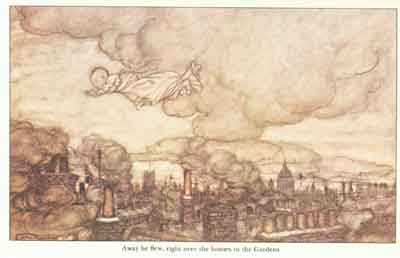
– • –
Modern perceptions of Victorians conjure up patriarchal legions of straight-laced, tight-lipped, sexually repressed individuals strictly conforming to social moirés. In 1983, Dr. Dan Kiley coined the term, the Peter Pan syndrome, to describe men who engage in adolescent behavior by refusing to grow up and take on the responsibilities that inevitably come with adulthood (13), or in Freudian terms, men permanently stuck in the latent stage. However, the Peter Pan syndrome existed long before 1983; Cecil Rhodes, the leader of the boy’s club of British imperialists once exclaimed, “I am a boy! Of course I shall never grow old” (Wilson 598). This imperial latency, termed “philistine boyishness” (Wilson 601), describes a world “stiflingly, overpoweringly male” (Wilson 600) and homosexuality, while not a socially recognizable identity, was nonetheless practiced in Victorian England. Homosexual “apologists…invoke[d] ancient Greece” and its homosocial model because “the prestige of Greece among upper middle-class Victorians…was so massive that invocations of Hellenism could cast a veil of respectability over even a hitherto unmentionable vice or crime” (Dowling 28). Oscar Wilde epitomized homosexual behavior in Victorian England and during his criminal trial for sodomy, he “passionately defend[ed] male love as the noblest of attachments, a love ‘such as Plato made the very basis of his philosophy’” (Dowling 1). Wilde’s lover, Lord Alfred Douglas, testified, “I did with him and allowed him to do what was done among boys at Winchester [Douglas’s school] and Oxford” (Wilson 563). Wilde’s trial occurred fifty years after Rhodes’ boyish declaration, when the imperialist Spartan boy’s club of adventurers, explorers, merchant seaman and colonizers had long since left the British isles seeking adventure, only to find themselves replaced by the grandchildren they left behind: effetes clinging to the skirts of Queen Victoria and the mother country.

– • –
The forever-adolescent latent male attitude finds wide circulation in British literature. The narrator in Barrie’s precursor to Peter Pan, The Little White Bird, finds himself “characterized as a retired soldier and bachelor London clubman” (Hollindale xix), regaling children with fables of Kensington Park, while Wilde’s dramatic cast in The Importance of Being Earnest lead double lives to satisfy sexual whims and avoid marriages or prolong engagements. P.G. Wodehouse’s Bertie Wooster, a member of London’s male Drone Club, forever runs from the marriages arranged by his domineering aunt only to be rescued by his manservant, Jeeves; while John Mortimer’s Rumpole of the Bailey, a first rate barrister, finds himself married to “she who must be obeyed.” This theme or neurosis of weak-willed effete men present in Imperialist Victorians carries into the present day in Nick Park’s Wallace and Gromit claymation series, where Wallace, an eccentric English inventor, refuses to marry and needs constant rescue by his faithful dog, Gromit. In all these works, the lower classes, reflected by a manservant (or a dog), need to save England from its pathetic patriarchal upper classes, to inject a new vitality in the gene pool. Coincidence aside, one can’t help but think this social backdrop of effete, irresponsible forever adolescent men, at least in part, produced J.M. Barrie’s Peter Pan, the boy who refused to grow up, and Rackham’s pictorial utopia of erotic domestics cheerfully waiting for their men to return.
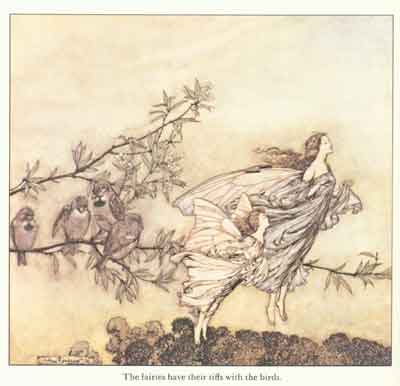
–
• –
Many of Peter’s depictions show him accompanied by what Barrie calls fairies, even though some individuals more closely resemble dwarfs or trolls. This dichotomy in the nocturnal world of Kensington Park can be explained by social stratification. The “aristocratic fairies” (Barrie 92), ruled by Queen Mab, are “high born” “blue bloods” (Barrie 93) that do not willingly associate with the lower order containing, “poor street singers” (Barrie 94), “nannies” (Barrie 58), “post-men” (Barrie 60), or “common people” (Barrie 59). There are even classical “Cupids” in fairy society (Barrie 91, 99), though ineffectual as the harbingers of love. Rackham’s illustrations display this diverse social group. Historically, fairies are spirits of the air, sometimes thought of as angels that have fallen from heaven, who were not bad enough to end up in hell (Parker 21). They are “far from angelic, given to stealing babies” (Parker 22), but they are petite and beautiful creatures (Parker 22) as Rackham’s illustrations depict. England has a special fascination with these creatures, especially since they inhabit the Cottingley countryside where they allowed themselves to be photographed (Parker 12) as reported by the renowned Sir Arthur Conan Doyle in his 1922 work The Coming of the Fairies. It is striking that the man who created the logical Sherlock Holmes fell for such a hoax. In 1983, the photographer finally explained how she cut pictures out of a children’s book, glued them to cardboard, set them up with hatpins, and then took her series of pictures (Willis 3). Alongside fairies, live dwarves or trolls, spirits of the earth, traditionally known for their skill at metal working (Brewer’s 1203) with “faces like men (ugly men, with wrinkled, leathery skins)” (Parker 12), similar to the troll-like fairies attending or frolicking with the aristocratic fairies in many of Rackham’s various illustrations. Dwarves, or trolls, live in the “darkest of caverns and venturing forth only with the cloaks by which they can make themselves invisible, and often disguised as toads” (Parker 12). In Peter Pan the various fairy species, or hierarchies, only come out at night when humans are “lock[ed] out” (Barrie 26) of the gardens. In mythology, dwarves are said to be Teutonic, Icelandic or Scandinavian (Parker 12), while Brownies find their roots in Scotland as a spirit of the home, doing good when all are asleep (Brewer’s 172). Even though technically a fairy, the Brownie of Barrie’s text is a “poor street singer” (94) who, while a pleasant enough creature, has designs on the Duke. Mushrooms or toadstools are often depicted in Rackham’s illustrations and Barrie’s text tells the reader, “the fairies sit round on mushrooms” (65), while the fairy workmen are found, “sawing down a toadstool” (25). Further, Barrie tells of a gathering at the “fairy ring” (95) and mushrooms have long been associated with fairy rings, those dark depressions in English lawn, often encircled by toadstools, caused by midnight fairy dances. In The Tempest, Shakespeare tells the audience of, “demipuppets that / By moonshine do the green sour ringlets make, / Whereof the ewe not bites; and you, whose pastime / Is to make midnight mushrumps” (V.1.43-46). Barrie’s classically inspired Peter Pan inhabits an idealized Victorian mythic community with northern pagan roots.
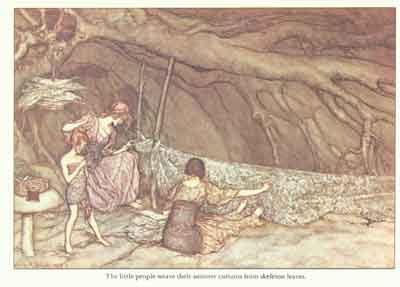
– • –
The illustration labelled figure one, of the boy who refused to grow up presents the viewer with classic, pagan, Christian, hierarchical and erotic themes. Entitled “Peter Pan is the fairies’ orchestra," Peter plays the panpipe, a classic instrument usually associated with erotic satyrs, as he accompanies dancers in ecstatic frenzy reminiscent of the followers of Dionysus or Roman Bacchus, the twice born. Peter, also twice born, abandoned his middle-class London nursery choosing to live in the fairy world. Unlike Peter’s namesake Pan, whose mixed theriomorphic appearance manifests as half-goat, half man (Jost 1103), Peter resembles Dionysus displaying wholly human characteristics. Both Dionysus and Pan are associated sexually with the reed pipe and Peter’s oral fixation with the instrument connotes the child development stage when “the oral impulse becomes auto-erotic” since “the first object of the oral component of the sexual instinct is the mother’s breast which satisfies the infant’s need for nutrition” only to make “the act of sucking for its own sake the erotic component” (Freud General 338). Peter’s sexuality is revealed to the viewer by the caption under the illustration stating his male moniker “Peter” while his quasi-orgasmic display, reflected by his closed eyes and curled toes, betrays his sensuousness. The etymology of Peter as penis is vague, however it is traced to the beginnings of the 20th century. Peter’s half-bird theriomorphism, and his aged status, reveals itself through his virtuosity on the panpipe. At the front of the picture, the Bacchanal-like dance-line contains a female and a couple of male fairies, some trolls, amphibians and mice of indeterminate sexuality. Like the view of Peter, the rodents and amphibians are asexual. Fairy sexuality and hierarchy can be determined by clothing, with women wearing stylized female dress and hairstyles while males sport manly attire of both high and low-class varieties. The woman dancing with the leering vigorous troll (lower right), wears a diaphanous flowing gown reminiscent of a Greek stola, to go with her fairy wings, while the central female wears a classically inspired peasant-type dress with shoulder scarf. This central middle-class yet rustic fairy, bears no wings and neither does the male fairy she dances with who wears very courtly Elizabethan garb. Further, her partner is an effete, the embodiment of the neutered English male, who seems more concerned with the proper bow, his hair and clothes, than injecting his genetic material into the fairy gene pool. The hierarchical fairies are sub-human and will never be Peter’s equal; they cannot even produce their own music and they associate with animals of a low order (rodents and amphibians) while Peter does not interact with any inhabitants and appears lost in his music. The viewer is presented with a society that values frogs, mice, deformity, depravity, anarchy and dance with the fairies representing romantic notions of natural, earth loving, sexualized pagans. The classically inspired Peter dominates the central portion and presents the Victorian view of children as others or monsters. The troll-like libido of the unconscious mind dances before the viewer’s eyes, with the conscious mind subliminally engaged in music of the id (the normal conscious state of babies) and the superego becomes an impotent phallic Christian spire far off in the distance.

– • –
In figure two, the illustration’s caption contains a large amount of text, which Nodelman believes, shows “events are not always what the words say they are” (79). “The Serpentine is a lovely lake, and there is a drowned forest at the bottom of it. If you peer over the edge you can see the trees all growing upside down, and they say that at night there are also drowned stars in it.” This caption speaks of a “drowned forest at the bottom of the [the Serpentine Lake]”, but the illustrator depicts the reflection of the forest of Kensington Gardens in the water. The text depicts child-like logic, “a drowned forest,” while the picture depicts reality, a mere reflection, making this fairy world desirable to child readers; a portrayal of make-believe grounded in reality. The realm Rackham portrays gives the nursery viewer a picture of Kensington Garden’s nocturnal fairy kingdom while instilling Victorian values of beauty, Hellenism and gynoculture. The “Fairies of the Serpentine” is one of Barrie’s favorite Peter Pan illustrations (Hudson 66) and presents the sexualized female fairy community in their amniotic element. Serpentine means snake, an ancient phallic symbol, whose prostatic water penetrates the cave-like womb, openings under the bridge portraying the birth canal of the fairy realm. The fence, an impotent barrier to the outsider, warns the viewer against trespassing into the water. However, the phallic fence barely reaches into the vagina of the fairy kingdom. The light of the painting depicts dusk, a moment that is neither day nor night, when magical things happen, especially in literature. The female fairies presented in the foreground wear diaphanous gowns and their wings resemble those of the dragonfly or a butterfly. They are the embodiment of Victorian beauty: perfectly proportioned, thin-limbed, white-skinned with long, curly auburn hair. Victorian male eroticism presents a group of Amazons seen sexually clasping one another while reaching for another to join in their play. In order for the pseudo-Hellenistic homosocial society to manifest itself, Victorian women must be willing to join a gynosocial community where they are content to entertain themselves and their children. The unconscious id, represented by the dragonfly (lower order insect, like trolls or amphibians), listens to the fairy ego displaying the gynocommunity’s balance between the unconscious and the patriarchal superego by internalizing the discipline needed to prevent anarchy. As a result, the need for male militancy is displaced, providing females the opportunity for sexual satisfaction, while, at the same time, giving men a voyeuristic view of the Victorian harem.

– • –

– • –
Through
all restraint broke loose he wings his way
Not
far off heav’n, in the precincts of light,
Directly
towards the new-created world,
And
man there placed, with purpose to assay
If
him by force he can destroy, or worse,
By
some false guile pervert (PL 3.87-92)
The illustration entitled, “The Kensington Gardens are in London, where the King lives,” (figure 5), pulls the onlooker into the image making the viewer just another interloper observing the King’s progress. Not only are the fairies interested in the comings and goings of the human King, but so too, the vegetation, which comes to life, either basking in his honor and power, or accepting the King’s salute as an acknowledgement of nature’s supremacy. Nevertheless, in Victorian England, whether inside or outside fairyland, the power ultimately rests with the superego, the King, whose marshal-like walk and salute make clear his regimental duty as warrior while his phallic-erect stiffness reminds everyone he’s the one who must be obeyed. The id, visible in the foreground and again represented by the prank prone lower-class troll-like, fairies cheerfully observes the superego King, the ultimate moral judgment in Victorian society, in a, not to say completely respectful, but nonetheless, quiet way. But, who exactly is in charge here? The wizened tree closest to the fence mimics human royalty by lifting a laurel-leaf crown in the king’s direction. Along with the classic Peter, the troll/fairy kingdom adopts the ancient evergreen symbol of honor for heroes, scholars and poets. The laurel also had protective powers, but more importantly, especially to the vegetable kingdom, in ancient Greece and Rome it was profane to use laurel as firewood (Ombrello 2). In any case the King appears ignorant of the id’s existence, and his ambivalence towards the fairies resembles his attitude towards the majority of his subjects--the people he rules and safeguards. Even so, while the King maintains the central power position because of his size and dark color, the female fairy middle-class and the viewing interloper occupy the forefront, pulling fairyland “betwixt and between” reality. On the other hand, the large size and predominance of the laurel-crown holding tree, compared to the king, also pulls “betwixt and between” reality where the accident of birth has made an ordinary human being extraordinary in his noble status. But, the viewer also observes the fairies’ accidents of birth, or class structure; middle-class females, freemen, servants, babies and pets exist alongside prescient vegetation while the King’s parade allows the fairy classes to rub elbows. Reflecting the Hellenistic homosocial desires of the Victorian male, no fathers appear in the fairy middle-class nursery. The troll-like fairies of the id occupy the middle right of the picture and their deformity, demeanor and clothing mark them as lower-class individuals--visions of the unconscious, passionate, irrational and physical. The gynosocial fairies of the ego maintain the foreground where they attempt to show their offspring the King and their mice servants oversee the chaos the King’s stroll elicits. Due to their ability to communicate with one another, the hierarchy of the garden includes not only fairies and trolls, but also mice and vegetation. Evoking an erotic harem, the winged fairies again appear in a state of Hellenistic undress that, since their backs are to the observer, allows a longer peek at their perfect forms. Even though scantily clad, these fairies appear to feel no threat from the males in their midst. Is it due to the effete homosocial fairycrats? Perhaps, the superego King in their midst keeps their manners, and libidos, in check. After all, it’s the King’s garden and the snap of his finger could result in the decimation of their home. This presentation shows the underground habitation of the fairies where living tree roots serve as houses and mother Earth provides the real estate. Fertility rests with the fairies that not only have babies but also their verdant vibrancy eliminates the need for garments while the vegetation appears withered and the King’s clothing evokes fall or winter. The youngsters of the Victorian nursery got a lesson in hierarchy and sex-role stereotyping from this vision of Fairyland where the nursery cheerfully produces and maintains children, womb’s work in a gynosocial community.
Class structure and its social distinctions played an essential role in Victorian culture and “The fairies have their tiffs with the birds,” (figure 6), illustrates the clash between bird and fairy society providing Victorian children with the proper response to the lower-classes. The reader never learns why the birds and fairies quarrel, only that “they usually give a civil answer to a civil question” (Barrie 25). In other words, they live in perpetual annoyance with one another. These two species occupy the same realm of Kensington Gardens, and because they both have the capacity of flight, their overlapping community brings them into conflict with one another. The upturned noses, closed eyes and stiff backs of the fairies exhibit their haughtiness, who even though adept at flying, just drift by the birds without deigning to use their wings. The birds also appear miffed and ruffle their feathers in response. Even so, the fairies must maintain the proper balance between anarchy (the birds of the id), and superego militancy (king/men), and the appropriate weapon for a well-brought-up fairy, likewise a Victorian lady, was the snub. The fairy gynoculture may not like being reminded of their theriomorphic condition, which unlike Peter Pan, manifests itself physically through exposed wings for flight. The woman’s appearance resembles a Greek statue; smooth skin, exposed neck and draped stola; an aristocratic mother teaching her daughter the fine art of rebuff through imitation, in much the same way, Victorians (and Moderns) do. The idea of social structure and maintaining one’s place was so important to Victorian society that its fairy reflection presents the child reader/viewer a reminder of position and the way those of lower station (or genus) should be treated. Peter Pan in Kensington Gardens did not find itself in a lower-class nursery, if such a thing even existed; it inhabited the upper-class nurseries of the homes surrounding Kensington Gardens.
Homer’s Penelope appears as one of “The little people [who] weave their summer curtains from skeleton leaves” in figure 7. The picture of domestic bliss, eternally beautiful, always erotic, forever cheerful; she represents the fantasy of a Hellenized female in a gynocommunity, pleased to accommodate the homosocial order desired by Victorian men. The central figure demonstrates the serene female in an idealized role; mother, friend, sister, governess, domestic goddess. As Elaine Showalter points out in her essay, “The Female Tradition,” “the middle-class ideology of the proper sphere of womanhood, which developed in post-industrial England and America, prescribed a woman who would be a Perfect Lady, an Angel in the House, contentedly submissive to men, but strong in her inner purity,…queen in her own realm of the Home” (1108). In contrast to the previous illustration, this mother/daughter team does not have wings, and their lack of clothing makes it apparent they are not hidden away. Apparently wings are appendages that appear only when needed or wanted, or possibly worn like hats or cloaks. The skeleton leaves being used as raw material for the loom resembles fairy wings, but they are the product of woodland decay formed as the “vascular tissue [that] provides support for the leaf” (Leaves 4) remains behind while the internal cells of the leaf decompose. However, like the females of the previous illustration, we find imitation of female sex role stereotypes developing in the fairy child; she is threading the needles needed for the weaving. In Victorian England where weaving was a mainstay of the industrial revolution and mechanized looms performed this once cottage industry, the gynosocial fairy world presents a romantic nostalgic response to the impersonal industrial revolution. Even if the fairy occupies a rustic-type residence, her clothing and physical appearance betray an upper middle-class lifestyle whose weaving is a response to the impersonal factories of Victorian England which dehumanized its workers, especially women. The individual weaver is unimportant, and her back is presented to the voyeur while the raw material needed for weaving hangs close at hand and her thread sits on a mushroom table, the mushroom long associated with traditional English fairy rings. She occupies a womb-like room in the roots of a tree with overlapping folds of earth resembling labia and a vaginal-like canal visible in the background. Hellenistic in style, the clothing displays an oriental flair conforming to Victorian fashion; however, the amount of skin shown is appropriate only for a boudoir where the occupation of the womb is paramount.The Hellenistic harem present in this illustration reminds Victorian women of their proper social roles, especially those in the home, which should be practiced cheerfully, skillfully and routinely. Once an idealized gynoculture is established the Hellenistic homosocial order can be practiced without guilt or worry; the women will be properly occupied and ready for service.
In “Butter is got from the roots of old trees,” (figure 8), the viewer is presented with an aristocratic fairy venturing out of Mother Earth in order to perform another typically female occupation: to shop. Women, marginalized to the harem, also perform the stereotypical sex roles of a Hellenized Victorian homosocial society. The fairy’s clothing covers her from neck to toe; no peeking breast, no white limbs or auburn hair, and from the bulk of the cloak she wears, her wings must be folded inside, if she has chosen to manifest them. Her outer cloak is less Hellenistic in style than the diaphanous gowns of the boudoir. The tree itself, home to troll-like fairies, looks dark and threatening, almost hellish, while the rustic female tends her baby and her business and her husband slices the butter on a mushroom table. Like the previous weavers, this cottage industry stands in stark contrast to the impersonal production of the Victorian industrial revolution while presenting a nostalgic look at the primeval nature of homely work. The nightmare trees appear prescient and the text warns the viewer of their advanced age, an “old” forest, a place where children are often lost in fairy tales. The womb-like trees appear old and dry, their freshness gone, with butter, not milk, the by-product, conjuring dried-up breasts. While the old forest may be suitable for peasant trolls, if female fairycrats leave the gynoculture of the harem, they find themselves facing a threatening barren world with nothing to offer them.
In “‘My Lord Duke,’ said the physician elatedly, ‘I have the honour to inform your excellency that your grace is in love,’” (figure 9), the viewer suddenly finds themselves in the court of the male fairyocracy. These effetes display varying stages of costume, from Elizabethan curls and lace, along with dress-like judicial robes, wigs and glasses, to the oriental robes and turban of the potentate. The long-curled hairstyles of the men, while historically accurate, resemble female hairdos, like the one worn by the woman at top left that contains a mass of feathers. The men display lace from cuffs to neckline and wear hose to show off their legs. The doctor bowing to deliver the information to the Duke feels particularly slimy with his long feminine fingers and spit curls stuck to the side of his baldpate; the viewer can imagine the oil in his voice. Even his skinny knees leer out at the viewer. The Duke needs to be informed of his newfound love because the gynosocial/homosocial divisions of this fairyocracy have made heterosexual love unnecessary. Startled, the court stares at the newly arrived fairy gypsy, Brownie, a “poor street singer” (Barrie 94) (middle right): a Cinderella-like choice, appropriate for the Victorian nursery. She marks the first appearance of a lower-class fairy with upper-class beauty, apparently the only requirement necessary for the vessel of the Duke’s heir. Rackham’s depiction is a departure from Barrie’s text where Brownie is described as “homely” and “plain” (94). Imported from abroad, the Duke is the least effete looking of the court crowd and bears facial hair. For upper-class female fairies, breeding occurs with the help of the lower-class troll-like fairies seen in the bacchantic celebrations previously illustrated. In this case, when the Duke needs to produce an heir his choice is far from troll-like, however he has made a choice that will inject some badly needed diversity into the aristocratic gene pool. Rackham also includes a pillowed crown, which has no place in Peter Pan but does introduce a young male servant. The two children illustrated are marginalized objects of the Duke: the boy, his slave; the girl, his wife; making pedophilia and homosocial/homosexual tendencies a part of the fairy court. The desired homosocial society represented by the boy is undermined by a heterosexual pedophilic desire for the girl lover/wife.
In “The fairies sit round on mushrooms, and at first they are well behaved,” (figure 10), it appears the women are cavorting with fairies of a lower order. We again see fairy furniture in the form of the toadstool, or mushroom. However, in this illustration they are used as chairs, in the same way Peter used them in figure one, rather than the customary table. A tablecloth marks the boundaries of the trestle where food is being served. In this graphic the viewer is privy to a picnic…a frivolous outdoor affair that escapes the confines of the interior where decorum can be set aside and play can ensue. While the males display the characteristics of the effete fairycrats in the prior illustration, they are nonetheless trolls in Elizabethan clothing. Trolls have, until this point, represented the unconscious libidinal id, and so the upper fairy classes dressed-up the sexual unconscious in order to maintain the population. In other words, it appears the homosocial effetes transferred their genetic responsibilities to the lower-classes by clothing them in upper-class garb. The diaphanous harem gowns of the females are loose and flowing with low necklines while the male dinner guests are deformed; with a dwarf, a midget, and even a rodent attending. The women appear to take no undue notice of their malformed guests and chat coyly with them. The text of the picture leaves open to question what kind of bad behavior will ensue; though the viewer knows some sort of pandemonium will begin shortly. The term “well-behaved” translates easily into the Victorian nursery where females and children are “well-behaved,” marginalizing the lady fairies to the level of children, confident that the “outbreak of anarchy…where animals act like children because children display animal-like urges” (Nodelman 75, 76) will inevitably ensue. The male guests appear to be relatives of the serving men (shown at the back), a well-dressed but disagreeable looking lot attending the upper-classes. The reader can count on the outbreak of the unconscious id amongst the “well-behaved” leading to bacchantic revelry where the gynosocial fairies mix with the trolls to procreate.
The idealized society presented in Rackham’s illustrations presents a cheerfully domestic gynoculture, producing and raising children in a displaced response to England’s industrial revolution and the Empire’s imperialist boy’s club’s desire for a Greek homosocial order. The baby Peter Pan, a Hellenized satyr, finds himself marginalized and thus condenses all children between purity and vice. The fairy women present voyeuristic images of Victorian male desire while condensing all women into Victorian models of chastity, purity and cheerfulness, leaving the men free to occupy their homoculture. The rustics find themselves living a pastoral existence while serving, and servicing their betters, thereby providing the fairy gene pool a much-needed boost. The illustrative products of Rackham’s unconscious display the moral authority of the superego through the human inhabitants (Peter and the King) while the sexually charged libido, or id, finds itself dancing among the trolls, rodents and insects, and the conscious ego walks a fine line between liberating sexuality and the desired gyno/homocultures of the fairies. Victorian English children view Rackham’s subconscious through his illustrations for Peter Pan In Kensington Gardens which fills gaps in Barrie’s text by portraying distinctions among hierarchy, sexuality, Hellenistic desires, sex role stereotypes and anarchy; but this mirror, like all mirrors, displays reverse reflections, and the viewer sees the gynoculture necessary to accompany the Victorian desire for an idealized Hellenistic homosocial society.
Endnotes
______________________
[1] The first appearance of Peter Pan occurred in The Little White Bird published in 1902, followed by the dramatic performance of Peter Pan in 1904 with Peter Pan in Kensington Gardens appearing in 1906 and consisting of the middle chapters of The Little White Bird (Hollindale xxxiv).
Works Cited
Barrie, James M. Peter Pan in Kensington Gardens: A facsimile of the 1906 Edition. New
Christmas%20Catalogue%
Brewer’s Dictionary of Phrase and Fable. Rev. by Adrian Room. Millennium Edition. London:
Freud, Sigmund. Civilization and Its Discontents. Trans. and Ed. by James Strachey. New
Henrichs, Albert. “Dinoysus.” Oxford Classical Dictionary. New York: OUP, 1999.
Hollindale, Peter. “Introduction.” J.M. Barrie Peter Pan in Kensington Gardens, Peter
Hudson, Derek. Arthur Rackham, His Life and Work. New York: Charles Scribner’s
Jost, Madeline. “Pan.” Oxford Classical Dictionary. New York: OUP, 1999.
Kepner, Jim. “Review.” Hellenism and Homosexuality in Victorian Oxford by Linda Dowling. 24
iglr/review.html?rec_id=589>.
Kiley, Dr. Dan. The Peter Pan Syndrome. Men Who Have Never Grown Up. New York: Dodd, Mead & Co., 1983.
“Leaves.” Biology 203 Lecture Notes. 31 July 2004.
Milton, John. Paradise Lost. Ed. Scott Elledge. Norton Critical Edition. 2nd Ed. New York:
alice_peter_pan.html>
Nodelam, Perry. “Decoding the Images: Illustration and Picture Books.” Understanding Children’s Literature. Ed. Peter Hunt. New York: Routeledge,
Ombrello, Dr. T. Plant of the Week. “Laurel.” 30 July 2004. <http://faculty.ucc/edu/biology-
Parker, Derek and Julia. The Immortals: The Mysterious World of Gods, Goblins, Fairies,
Plant, Bud. “Arthur Rackham.” Bud Plant Illustrated Books. 19 January 2004. <http://www.bpib.com/illustrat/rackham.htm>
Rackham, Arthur, Illustrator. J.M. Barrie Peter Pan in Kensignton Gardens: A facsimile of the
Shakespeare, William. The Tempest. Ed. Louis B. Wright. Folger Library Edition. New York:
Wilson, A.N. The Victorians. New York: W.W. Norton & Co., Inc., 2003.
